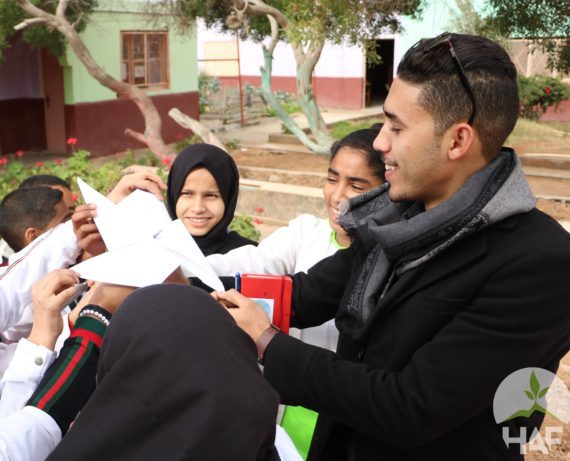
Tim Ager
Vising Engineering Expert
USAID Farmer-to-Farmer Program
My image of Morocco was dry, a desert, and not a place of agricultural growth. I was surprised by the vast olive groves and orchards of fruit trees often visible from the window of my train as I travelled from Marrakech, through Casablanca and Rabat, to Fez. Unfortunately, not all Moroccans experience the financial benefits that such trees can provide.
Most rural Moroccans are subsistence farmers who survive by growing corn and barley – the low market value staple crops that are planted on 70% of Morocco’s agricultural land, but account for only 10-15% of the country’s agricultural revenue. This way of life is no longer sustainable, and the High Atlas Foundation (HAF) has taken on the challenge of breaking the cycle of poverty that entraps those who depend upon agricultural production.
HAF has developed nurseries across the country to grow fruit and nut trees including pomegranate, fig, olive, almond and walnut. After a couple of years these trees are mature enough to be given to individuals in rural communities to help them increase their agricultural revenue. The trees are also distributed to schools, providing the opportunity to teach the next generation of Moroccans how to plant and care for trees. And the planting of trees brings additional environmental benefits: soil erosion prevention, deforestation reversal, and climate change mitigation.
Over the last two weeks, I visited many of these nurseries on a Farmer-to-Farmer assignment funded by the United States Agency for International Development (USAID). My job was to assess existing drip irrigation systems and to design irrigation systems for future nursery sites.
One of these sites is located in Fes, at the Center for the Protection of Children – Abdelaziz Ben Driss, a welfare institution that serves children in vulnerable situations, those with legal problems, and/or minors in detention. The Center provides vocational training in carpentry, ironwork, IT, literacy, and gardening. On my visit to the Center I saw a large garden plot (approximately 800m2) already tilled and partially planted with aromatic and medicinal herbs. All that was lacking was an irrigation system. The design for this nursery includes two plots totaling nearly 3,000m2, with a drip irrigation system that will water the garden plot as well. The opportunity to help install and maintain this irrigation system and the day to day care of plants will help engage the minds and bodies of the young people who live at the Center.
I visited nurseries at the Collège Housseine Bin Ali in Moulay Yacoub (Fes region), and the Al Akhawayn University in Ifrane, which are models for future nurseries at the Universitè Sidi Mohamed Ben Abdellah – Appied Sciences campus in Fes and at the Salam School in Ifrane. These nurseries will provide opportunities for children and young adults to learn about improved irrigation practices, caring for plants, and to spread their knowledge across Morocco. But the skills obtained from working directly with these nurseries can be much greater – including critical thinking, problem solving, engineering and design, communication, mentorship, and community service.
There is no disputing the positive effects of HAF’s nurseries – from educational, to environmental, to financial. But in reality, how much good can a few trees do? It’s all a question of scale. HAF has already planted over two million fruit and nut trees in Morocco. While this is a significant number, it’s only a fraction of Morocco’s national goal of planting one billion trees to overcome the inherent problems of subsistence agriculture. Consider that number: one billion. It seems impossible. How do you grow a project from one million trees to one billion trees? It all starts with the next nursery, the next seed. Another seed planted in the ground. Another seed planted in the mind of a child.





